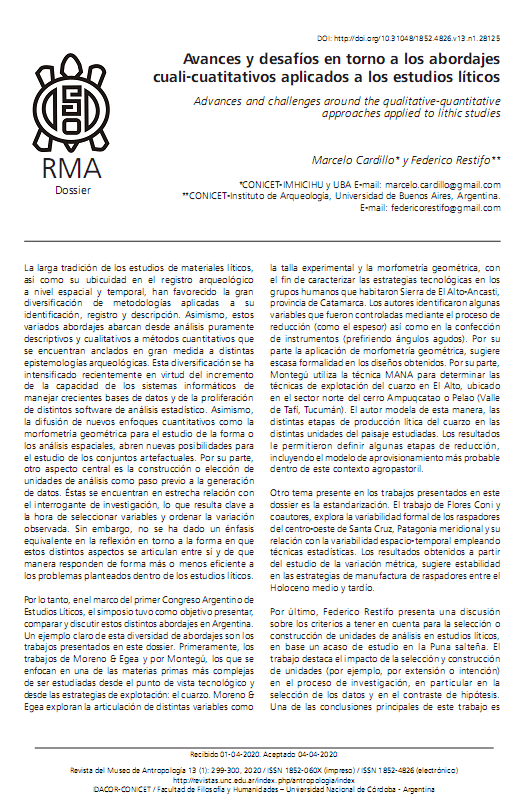Advances and challenges around the qualitative-quantitative approaches applied to lithic studies
DOI:
https://doi.org/10.31048/1852.4826.v13.n1.28125Keywords:
Lithic studiesAbstract
The long tradition of studies of lithic materials, as well as its ubiquity in the archaeological record at a spatial and temporal level, have favoured the great diversification of methodologies applied to its identification, record and description. Furthermore, these varied approaches range from purely descriptive and qualitative analyses to quantitative methods that are largely anchored to different archaeological epistemologies. This diversification has recently been intensified due to the increase in the capacity of computer systems to handle growing databases and the proliferation of different statistical analysis software. Likewise, the diffusion of new quantitative approaches such as geometric morphometry for the study of shape or spatial analysis, open up new possibilities for the study of artefactual sets. On the other hand, another central aspect is the construction or choice of analysis units as a previous step to the generation of data. These are closely related to the research question, which is key when selecting variables and ordering the observed variation. However, there has not been an equivalent emphasis on reflection on the way in which these different aspects are articulated with each other and in which way they respond more or less efficiently to the problems posed within lithic studies.
Downloads
References
N/D

Downloads
Published
Issue
Section
License
Those authors who have publications with this Journalaccept the following terms:
a. Authors will retain their copyrights and guarantee the journal the right of first publication of their work, which will be simultaneously subject to the Creative Commons Attribution License (Licencia de reconocimiento de Creative Commons) that allows third parties to share the work as long as its author and his first publication in this journal.
b. Authors may adopt other non-exclusive licensing agreements for the distribution of the version of the published work (eg, deposit it in an institutional electronic file or publish it in a monographic volume) provided that the initial publication in this journal is indicated.
c. Authors are allowed and recommended to disseminate their work on the Internet (eg in institutional telematic archives or on their website) before and during the submission process, which can lead to interesting exchanges and increase citations of the published work. (See The Effect of Open Access - El efecto del acceso abierto)











